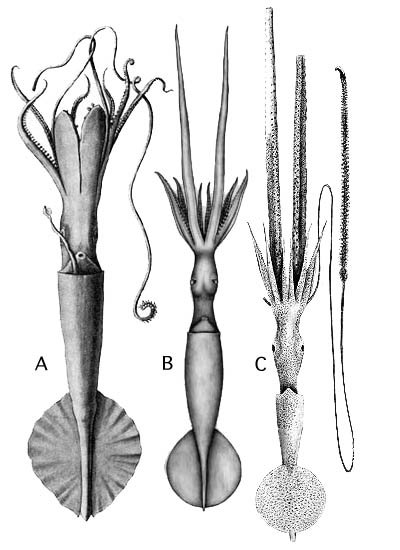Chiroteuthis mega
Clyde F. E. Roper and Richard E. YoungIntroduction
C. mega has a similar tentacular club to that of C. picteti but is easily recognized by the absence of visceral photophores. Other unusual features are the arrangement of ocular photophores, the slenderness and elongation of the mantle, head and arms IV, and very long clubs with an especially large club-tip photophore.
Diagnosis
A Chiroteuthis ...
- without visceral photophores.
Characteristics
- Arms
- Large arm suckers with 20-30 teeth around entire ring. Teeth slender, pointed, separate distally; truncated, separate laterally; broadly rounded, in contact proximally.
- Largest suckers not globular.
- Tentacular clubs
- Suckers with enlarged, conspicuous central tooth.
- Sucker stalks weakly divided into two parts: proximal portion with thick, delicate keel with terminal swelling (=flag). Stalks of lateral suckers much longer (ca 2X) than stalks of medial suckers.
- Protective membranes in two sets with proximal set less than one tenth length of distal set and only slightly broader than distal set.
Figure. Oral view of the tentacular club of C. mega. Drawing from Voss (1967).
- Head
- Beaks: Descriptions can be found here: Lower beak; upper beak.
- Beaks: Descriptions can be found here: Lower beak; upper beak.
- Photophores
- Eyeball: Lateral series= 8 separate organs (may coalesce to irregular stripe , 1); intermediate series = stripe with nearly separate photophore at posterior end; medial series = stripe.
- Viscera: Photophores absent.
- Pigmentation
- Club sucker stalks without pigment.
Comments
More details of the description of C. mega can be found here.Nomenclature
Chiropsis mega was described by Joubin in 1932 in a preliminary note on the male reproductive system and subsequently described and illustrated in detail in 1933. The single specimen, captured in the Sargasso Sea of the North Atlantic, was unusual in having short, broad ventral arms (thought to be hectocotylization by Joubin), a very short tentacular club, a single visceral photophore and a large penis. Our examination of the holotype found this squid to be an injured animal that had begun to heal damaged ventral arms and its remaining single club. The visceral photophore was actually a bend in the cephalic vein and visceral photophores are lacking. The absence of the visceral photophores is the main distinctive feature of the species. The large penis seems to be a characteristic of the genus Chiroteuthis. Therefore, the generic status of Chiropsis is untenable. MacDonald and Clench (1934) described a new genus and species, Bigelowia atlanticus, from the western North Atlantic off Bermuda from the same general region where C. mega was captured. The species was based on a single, mutilated specimen and was characterized by its very elongate, slender head and mantle. Roper et al. (1969) placed Bigelowia in the synonomy of Chiroteuthis. Our re-examination of the holotype of B. atlanticus shows that visceral photophores are absent and that the species is a synonym of C. mega. Finally, Voss (1967) described Chiroteuthis capensis from well preserved material from South Atlantic waters off South Africa. The most distinctive feature was the absence of visceral photophores which was thought to be a unique character at that time. This species was placed in the synonomy of C. mega by Salcedo-Vargas (1997) based on his re-examination of the holotypes of C. mega and C. capensis.
Distribution
C. mega is known from the North and South Atlantic and eastern North Pacific oceans. Relatively little geographical variation in sucker dentition was noted in either club or arm suckers.
References
Joubin, L. 1932. Note sur l'appareil reproducteur d'un céphalopode nouveau: Chiropsis mega. Bull. Soc. zool. France, 57: 288-291.
Joubin, L. 1933. Notes préliminaires sur les céphalopodes des croisières du DANA. Ann. Instit. Océanogr., 13: 1-49.
MacDonald, R. and W. J. Clench. 1934. Descriptions of a new genus and two new species of squids from the North Atlantic. Occ. Pap. Boston Soc. Nat. Hist., 8: 145-152.
Roper, C. F. E., R. E. Young and G. L. Voss. An illustrated key to the families of the order Teuthoidea (Cephalopoda). Smithson. Contr. Zool., 13: 1-32.
Salcedo-Vargas, M. A. 1997. Cephalopods from the Netherlands Indian Ocean programme (NIOP)-II. Mastigoteuthid lineage and related forms. Beaufortia, 47: 91-108.
Voss, G. L. 1967. Some bathypelagic cephalopods from South African waters. Ann. South African Mus., 50: 61-88.
Title Illustrations

| Scientific Name | Chiroteuthis mega, Chiroteuthis mega (2), Chiroteuthis mega (3) |
|---|---|
| Comments | Type illustration of Chiropsis mega, Illustration of the holotype of Bigelowia atlanticus (2), Type illustration of Chiroteuthis capensis (3) |
| Reference | From Joubin, L. 1933. Notes préliminaires sur les céphalopodes des croisières du DANA. Ann. Instit. Océanogr. 13:1-49., from Voss, G. L. 1967. Some bathypelagic cephalopods from South African waters. Ann. South African Mus. 50:61-88. (3) |
| Creator | J. R. Schroeder (2) |
About This Page

Smithsonian Institution, Washington, D. C., USA

University of Hawaii, Honolulu, HI, USA
Page copyright © 2019 and
All Rights Reserved.
- Content changed 22 November 2011
Citing this page:
Roper, Clyde F. E. and Richard E. Young. 2011. Chiroteuthis mega . Version 22 November 2011 (under construction). http://tolweb.org/Chiroteuthis_mega/19476/2011.11.22 in The Tree of Life Web Project, http://tolweb.org/









 Go to quick links
Go to quick search
Go to navigation for this section of the ToL site
Go to detailed links for the ToL site
Go to quick links
Go to quick search
Go to navigation for this section of the ToL site
Go to detailed links for the ToL site